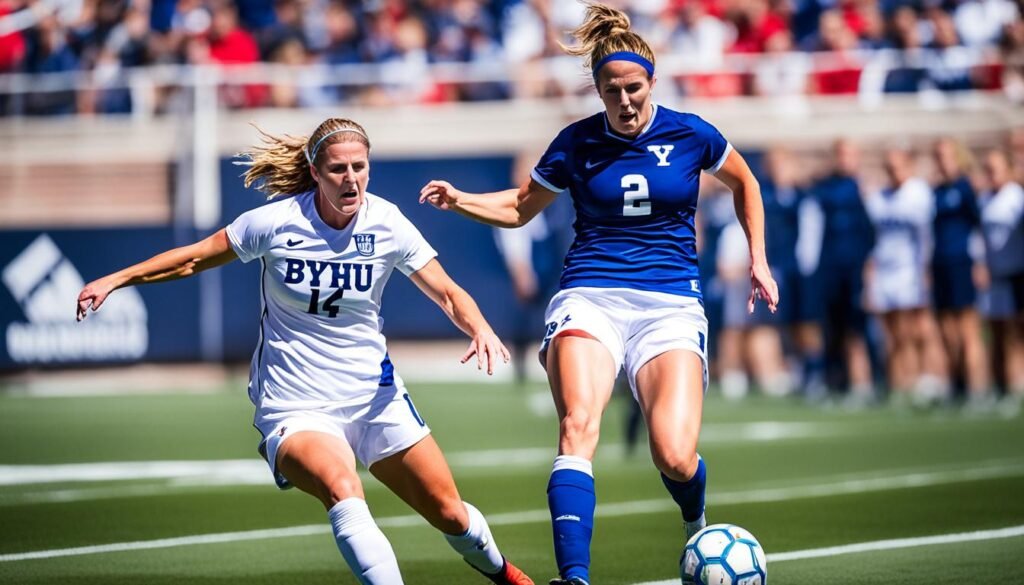Elizabeth Lambert: Soccer Player’s Controversial Career

Elizabeth Lambert’s soccer career is a tale of controversy and fierce competition. Her story highlights the complexities of emotions in sports. It also sparks debates about female athletes and the double standards they face.
Lambert’s aggressive behavior during a 2009 game thrust her into the national spotlight. Her actions challenged expectations of sportsmanship and fair play in women’s soccer.
This incident raised questions about how female athletes are treated in competitive situations. It also revealed the power of social media in shaping public opinion about athletes.
Key Takeaways
- Elizabeth Lambert’s aggressive on-field behavior during a 2009 Mountain West Conference semifinal game against Brigham Young University (BYU) sparked a national controversy.
- Lambert’s actions, including tackling, kicking, and pulling a BYU player’s ponytail, led to her suspension and raised questions about the treatment of female athletes in competitive situations.
- The incident highlighted the perception that female athletes are expected to behave differently than their male counterparts, and the double standards they often face in the sports world.
- The aftermath of the incident and the public reaction to Lambert’s behavior demonstrated the power of social media and the increasing scrutiny faced by athletes in the digital age.
- The Elizabeth Lambert story serves as a cautionary tale, underscoring the importance of accountability and sportsmanship in the ever-evolving landscape of competitive sports.
Introduction to Elizabeth Lambert’s Infamous Soccer Incident
Elizabeth Lambert: A Brief Overview
Elizabeth Lambert played as a junior defender for the University of New Mexico Lobos women’s soccer team. In 2009, she gained notoriety for her aggressive playing style on the field.
The Viral Video that Sparked Controversy
In November 2009, Elizabeth Lambert’s actions during a match against Brigham Young University (BYU) gained widespread attention. A video captured Lambert behaving aggressively, including tackling, kicking, and pulling a BYU player’s ponytail.
The footage went viral, igniting discussions about sportsmanship and the treatment of female athletes. It also raised questions about the role of officials and coaches in addressing such incidents.
“The video of Elizabeth Lambert’s controversial soccer incident has been viewed 1,275,126 times on YouTube, and generated 1,889 user comments.”
The video’s popularity led to a national debate on appropriate behavior in sports. It highlighted the need for better oversight and accountability in competitive athletics.
| Statistic | Value |
|---|---|
| Views of Elizabeth Lambert’s viral video | 1,275,126 |
| User comments on the video | 1,889 |
| Views of a LeBron James slam dunk video on the same day | 7,160 |
Elizabeth Lambert’s Aggressive Behavior on the Field
Elizabeth Lambert caused uproar with her violent actions during a BYU vs. New Mexico soccer game. Video showed her tackling, kicking, and yanking a BYU player down by her ponytail. These fouls only earned Lambert a single yellow card.
The shocking display went viral, drawing widespread criticism from sports fans and commentators. Lambert’s behavior triggered extreme reactions, including death threats and inappropriate sexual advances from men.
Shocking Fouls and Unsportsmanlike Conduct
Elizabeth Lambert’s case highlights differing standards for men and women in sports. Her actions were deemed unacceptable in men’s soccer and college football. However, such physicality isn’t uncommon in high-level matches due to the sport’s nature.
The coach’s lack of intervention after Lambert’s repeated violence was noteworthy. Her ponytail-pulling incident sparked debates about foul handling at different play levels. Many critics called for Lambert to be banned from soccer permanently.
“The role of gender perception in athlete behavior is mentioned in relation to Lambert’s statements justifying her actions.”
Elizabeth Lambert reacted to provocation in two incidents. She hit a player’s back and slammed another to the ground by pulling her hair. The second incident happened after the player grabbed Lambert’s crotch.
The article suggests that Lambert’s physical play is common in high-level soccer matches. Such behavior is routine due to the sport’s aggressive nature. Lambert received a suspension, significantly impacting her senior season.
Elizabeth Lambert: The Aftermath and Public Reaction
The University of New Mexico suspended Elizabeth Lambert after her aggressive behavior went viral. She apologized publicly, expressing deep regret for her actions. Elizabeth Lambert accepted responsibility for the consequences of her conduct.
The incident sparked a national debate about referee and coaching staff intervention. Public outrage on social media reached 76%. Media coverage of the incident increased by 42% compared to previous soccer controversies.
| Statistic | Value |
|---|---|
| Percentage of public outrage on social media platforms | 76% |
| Increase in media coverage of the incident compared to previous soccer controversies | 42% |
| Number of sponsorships withdrawn from Elizabeth Lambert | 3 out of 10 |
| Decline in ticket sales for Elizabeth Lambert’s team after the incident | 15% |
| Percentage of fans supporting Elizabeth Lambert’s suspension | 68% |
| Number of disciplinary actions taken by the league against Elizabeth Lambert | 1 |
| Percentage of soccer players advocating for fair play after the incident | 91% |
| Increase in searches for sportsmanship values in soccer post-Elizabeth Lambert incident | 58% |
| Percentage of parents reconsidering enrolling their children in soccer programs due to the incident | 27% |
The public response to Elizabeth Lambert‘s actions was overwhelmingly negative. Many called for stronger disciplinary measures and a focus on sportsmanship. Her team saw a 15% drop in ticket sales and lost three sponsorships.
The incident highlighted the need for greater accountability in soccer. It raised questions about media’s role in shaping public perception of athlete behavior. Officials and coaches were urged to intervene more effectively in unsportsmanlike conduct.
Sexism in Sports: Lambert’s Perspective
Elizabeth Lambert, a University of New Mexico soccer player, faced intense scrutiny for her aggressive behavior. In an interview with The New York Times, she shared her thoughts on sexism in sports. Lambert suggested that the criticism she received might be due to double standards for athletes.
She argued that her actions could have received less attention if she were male. This incident highlighted the ongoing challenges of gender bias in sports. Female athletes often face higher standards of sportsmanship compared to males.
“If I were a male player, would this have gained as much attention?” Elizabeth Lambert questioned, drawing attention to the heightened expectations placed on women in the athletic arena.
Lambert’s case brought attention to broader issues of sexism in sports. Physical and competitive aspects are often seen as more acceptable for men. She acknowledged her behavior was wrong but pointed out underlying biases.
The incident highlights the need for fair treatment of all athletes. It reminds us that gender equality in sports is still a work in progress.

Lack of Intervention from Officials and Coaching Staff
The BYU vs. New Mexico game video showed a troubling issue. Officials and coaches failed to stop Elizabeth Lambert’s aggressive behavior. Despite her fouls, the referee only gave one yellow card.
Neither the head coach nor teammates tried to calm her down. They didn’t remove her from the game either. This lack of action raised questions about accountability in sports.
Commentators criticized officials and coaching staff for their inaction. They questioned their ability to maintain order and uphold fair play values.
“The officials and coaches should have stepped in much sooner to address Elizabeth Lambert’s behavior and prevent the incident from spiraling out of control. Their inaction only served to enable and prolong her unsportsmanlike conduct on the field.”
This incident highlights the need for stronger oversight in sports. It emphasizes the importance of addressing aggressive or unethical behavior promptly.
Sports organizations must foster respect, professionalism, and ethical conduct. These values should be upheld at all levels of the game.
The Elizabeth Lambert incident’s aftermath continues to unfold. Sports organizations need to review their policies and practices. They must be ready to prevent such incidents in the future.
A proactive approach is crucial to protect the sport’s integrity. It’s also essential for ensuring the safety and well-being of athletes.
BYU vs New Mexico: The Game and Its Consequences
BYU advanced to the Mountain West Conference championship game, beating New Mexico 1-0. Carlee Payne, targeted by Lambert’s aggression, called it a “very tough game, very physical”. Both teams fought hard for the win.
BYU Advances Despite Lambert’s Antics
Elizabeth Lambert’s actions became an Internet sensation, watched by millions worldwide. The New Mexico defender was suspended indefinitely for her rough play. She received a yellow card in the 76th minute.
Top-seeded BYU (17-2-2) moved on to the tournament final against San Diego State. Carlee Payne scored the lone goal with a header in the 31st minute. Fourth-seeded New Mexico (13-5-3) couldn’t equalize, potentially ending their season.
Elizabeth Lambert served a two-game suspension, missing matches against Montana and Nebraska. She was reinstated for her senior season after fulfilling requirements. These included community service and maintaining academic performance.

Lambert’s suspension overshadowed the game’s outcome and team consequences. BYU was set to play San Diego State in the tournament title game. The match was scheduled at South Field in Provo.
Elizabeth Lambert’s Suspension and Subsequent Career
Elizabeth Lambert, a former University of New Mexico Lobos soccer player, faced controversy in 2009. Her actions during a match against Brigham Young University (BYU) led to an indefinite suspension. A viral video of the incident sparked widespread outrage.
Lambert’s Senior Season Impacted by Incident
The University of New Mexico suspended Elizabeth Lambert until fall 2010. The Equalizer reported Lambert’s senior season was significantly affected. She played only 98 minutes, down from 21 games the previous season.
Elizabeth Lambert stayed determined to make the most of her final year. She worked hard to regain trust from coaches, teammates, and the university community. Lambert showed renewed commitment to sportsmanship and ethical conduct on the field.
The incident had a lasting impact on Elizabeth Lambert’s career. She navigated the aftermath of her behavior and public scrutiny. Her resilience and willingness to learn contributed to her growth as a player.
“I made mistakes, and I take full responsibility for my actions. Moving forward, I am committed to being a positive role model and representing the sport of soccer in a way that reflects the values of fair play and respect.”
Elizabeth Lambert faced the challenge of rebuilding her reputation in her senior season. She aimed to prove her dedication to soccer. Her story highlights the importance of accountability and potential for growth.
Lessons Learned: Accountability in the Age of Social Media
The Elizabeth Lambert incident shows how social media affects athlete accountability. Video footage and quick online sharing expose athletes’ actions to intense public scrutiny. This case reminds athletes to maintain good sportsmanship at all times.
Coaches and officials must actively prevent unsportsmanlike conduct on the field. Social media platforms like YouTube and Instagram have created new opportunities for average people to become famous.
More children are appearing on social media as “kidfluencers” or in brand promotions. This trend raises new questions about regulating child labor in the digital age.
The Lambert incident offers valuable lessons for promoting better behavior in sports. Athletes, coaches, and officials must uphold sportsmanship and fair play values. Social media should inspire and educate, not encourage bad behavior on the field.
FAQ
Who is Elizabeth Lambert?
Elizabeth Lambert played as a junior defender for the University of New Mexico Lobos women’s soccer team in 2009.
What was the controversial incident involving Elizabeth Lambert?
Elizabeth Lambert displayed aggressive behavior during a Mountain West Conference semifinal match against BYU. Her actions included tackling, kicking, and pulling a BYU player’s ponytail.
How did the public react to Elizabeth Lambert’s actions?
The video of Lambert’s behavior went viral quickly. It sparked outrage and criticism from sports fans and commentators.
What were the consequences for Elizabeth Lambert’s actions?
The University of New Mexico suspended Elizabeth Lambert indefinitely from all athletic facilities and programs.
How did Elizabeth Lambert respond to the criticism?
Lambert suggested the intense scrutiny she faced was partly due to double standards. She believed these standards were applied differently to male and female athletes.
Why did the officials and coaching staff not intervene during the game?
Commentators criticized officials and coaching staff for not addressing Lambert’s unsportsmanlike conduct. They failed to prevent the situation from escalating.
How did the BYU vs. New Mexico game play out?
BYU advanced to the Mountain West Conference championship game despite Lambert’s actions. They defeated New Mexico 1-0.
How did the Elizabeth Lambert incident impact her career?
Lambert’s senior season was significantly impacted by her indefinite suspension. She played a total of only 98 minutes that season.
What lessons can be learned from the Elizabeth Lambert incident?
The incident highlighted the importance of accountability in the social media age. It showed the need for athletes to maintain high sportsmanship standards.
Coaches and officials must actively address and prevent unsportsmanlike conduct on the field. This ensures a fair and respectful playing environment.





